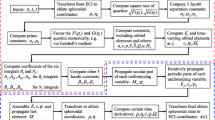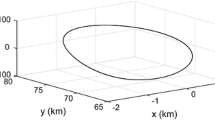Abstract
This work revisits the modeling of the relative motion between satellites flying in near-circular low-Earth-orbits. The motion is described through relative orbital elements and both Earth’s oblateness and differential drag perturbations are addressed. With respect to the former formulation, the description of the \(J_2\) effect is improved by including also the changes that this perturbation produces in both relative mean longitude and relative inclination vector during a drifting phase, when a non-vanishing relative semi-major axis is required. The second major improvement consists in a general empirical formulation to include the mean effects produced by non-conservative perturbations, such as the differential aerodynamic drag acceleration. As a result, in addition to the well-known actions on the relative semi-major axis and on the mean along-track separation, the model is able to reflect the mean variation of the relative eccentricity vector due to atmospheric density oscillations produced by day and night transitions.














Similar content being viewed by others
Notes
The relationship between ROEs and the relative Cartesian state is discussed later in Sect. 4.
References
Ardaens, J.-S., D’Amico, S., Fischer, D.: Early flight results from the TanDEM-X autonomous formation flying system. In: 4th International Conference on Spacecraft Formation Flying Missions and Technologies (SFFMT), St-Hubert, Quebec (2011a)
Ardaens, J.-S., D’Amico, S., Montenbruck, O.: Final commissioning of the PRISMA GPS navigation system. In: 22nd International Symposium on Spaceflight Dynamics, Sao Jose dos Campos, Brazil (2011b)
Ardaens, J.-S., Gaias, G.: Spaceborne autonomous vision-based navigation system for AVANTI. In: 65th International Astronautical Congress, Toronto, Canada (2014)
Ardaens, J.-S., Kahle, R., Schulze, D.: In-flight performance validation of the TanDEM-X autonomous formation flying system. In: 5th International Conference on Spacecraft Formation Flying Missions and Technologies (SFFMT), Munich, Germany (2013)
Ardaens, J.-S., D’Amico, S.: Spaceborne autonomous relative control system for dual satellite formations. J. Guid. Control Dyn. 32(6), 1859–1870 (2009)
Ben-Yaacov, O., Gurfil, P.: Long-term cluster flight of multiple satellites using differential drag. J. Guid. Control Dyn. 36(6), 1731–1740 (2013). doi:10.2514/1.61496
Bevilacqua, R., Romano, M.: Rendezvous maneuvers of multiple spacecraft using differential drag under J2 perturbation. J. Guid. Control Dyn. 31(6), 1595–1607 (2008)
Bodin, P., Noteborn, R., Larsson, R., Karlsson, T., D’Amico, S., Ardaens, J.-S., et al.: PRISMA formation flying demonstrator: overview and conclusions from the nominal mission. In: 35th Annual AAS Guidance and Control Conference, Number 12-072, Breckenridge, Colorado, USA (2012)
Brouwer, D.: Solution of the problem of artificial satellite theory without drag. Astron. J. 64(1274), 378–397 (1959). doi:10.1086/107958
Clohessy, W.H., Wiltshire, R.S.: Terminal guidance system for satellite rendezvous. J. Aerosp. Sci. 27(9), 653–658 (1960)
Colombo, O.L.: The dynamics of global position system orbits and the determination of precise ephemerides. J. Geophys. Res. 94, 9167–9182 (1989)
D’Amico, S.: Autonomous formation flying in low Earth orbit. Ph.D. thesis, Technical University of Delft, The Netherlands (2010)
D’Amico, S.: Relative orbital elements as integration constants of Hill’s equations. DLR-GSOC TN 05-08, Deutsches Zentrum für Luft- und Raumfahrt, Oberpfaffenhofen, Germany (2005)
D’Amico, S., Ardaens, J.-S., Larsson, R.: Spaceborne autonomous formation-flying experiment on the PRISMA mission. J. Guid. Control Dyn. 35(3), 834–850 (2012). doi:10.2514/1.55638
D’Amico, S., Ardaens, J.-S., Gaias, G., Benninghoff, H., Schlepp, B., Jørgensen, J.L.: Noncooperative rendezvous using angles-only optical navigation: system design and flight results. J. Guid. Control Dyn. 36(6), 1576–1595 (2013). doi:10.2514/1.59236
D’Amico, S., Montenbruck, O.: Proximity operations of formation flying spacecraft using an eccentricity/inclination vector separation. J. Guid. Control Dyn. 29(3), 554–563 (2006). doi:10.2514/1.15114
Dormand, J.R., Prince, P.J.: A family of embedded Runge-Kutta formulae. J. Comput. Appl. Math. 6(1), 19–26 (1980)
Gaias, G., Ardaens, J.-S., D’Amico, S.: The Autonomous Vision Approach Navigation and Target Identification (AVANTI) experiment: objectives and design. In: 9th International ESA Conference on Guidance, Navigation & Control Systems, Porto, Portugal (2014)
Gaias, G., D’Amico, S., Ardaens, J.-S.: Generalized multi-impulsive maneuvers for optimum spacecraft rendezvous. In: 5th International Conference on Spacecraft Formation Flying Missions and Technologies (SFFMT), Munich, Germany (2013)
Gaias, G., D’Amico, S.: Impulsive maneuvers for formation reconfiguration using relative orbital elements. J. Guid. Control Dyn. (2014). doi:10.2514/1.G000189
Härting, A., Rajasingh, C.K., Eckstein, M.C., Leibold, A.F., Srinivasamurthy, K.N.: On the collision hazard of colocated geostationary satellites. In: AIAA/AAS Astrodynamics conference, Number 88-4239, Minneapolis, USA (1988)
Ichimura, Y., Ichikawa, A.: Optimal impulsive relative orbit transfer along a circular orbit. J. Guid. Control Dyn. 31(4), 1014–1027 (2008). doi:10.2514/1.32820
Kumar, B.S., Ng, A., Yoshihara, K., De Ruiter, A.: Differential drag as a means of spacecraft formation control. IEEE Trans. Aerosp. Electron. Syst. 47(2), 1125–1135 (2011)
Lara, M., Gurfil, P.: Integrable approximation of J2-perturbed relative orbits. Celest. Mech. Dyn. Astron. 114(3), 229–254 (2012). doi:10.1007/s10569-012-9437-8
Leonard, C.L., Hollister, W.M., Bergmann, E.V.: Orbital formationkeeping with differential drag. J. Guid. Control Dyn. 12(1), 108–113 (1989). doi:10.2514/3.20374
Lovell, T.A., Tragesser, S.G.: Guidance for relative motion of low earth orbit spacecraft based on relative orbit elements. In: AIAA Guidance, Navigation and Control Conference and Exhibit, Number 04-4988, Providence, Rhode Island, USA (2004)
Martinusi, V., Gurfil, P.: Solutions and periodicity of satellite relative motion under even zonal harmonics perturbations. Celest. Mech. Dyn. Astron. 111(4), 387–414 (2011). doi:10.1007/s10569-011-9376-9
Mingotti, G., McInnes, C.: High area-to-mass ratio and small length-scale spacecraft formation flying applications. In: 5th International Conference on Spacecraft Formation Flying Missions & Technologies (SFFMT) Munich, Germany (2013)
Montenbruck, O., Kirschner, M., D’Amico, S., Bettadpur, S.: E/I-vector separation for safe switching of the GRACE formation. Aerosp. Sci. Technol. 10(7), 628–635 (2006). doi:10.1016/j.ast.2006.04.001
Pérez, D., Wohlberg, B., Lovell, T.A., Shoemaker, M., Bevilacqua, R.: Orbit-centered atmospheric density prediction using artificial neural networks. Acta Astronautica 98, 9–23 (2014). doi:10.1016/j.actaastro.2014.01.007
Pérez, D., Bevilacqua, R.: Differential drag spacecraft rendezvous using an adaptive Lyapunov control strategy. Acta Astronautica 83, 196–207 (2013). doi:10.1016/j.actaastro.2012.09.005
Pérez, D., Bevilacqua, R.: Lyapunov-based adaptive feedback for spacecraft planar relative maneuvering via differential drag. J. Guid. Control Dyn. 37(5), 1678–1684 (2014). doi:10.2514/1.G000191
Schaub, H., Junkins, J.L.: Analytical Mechanics of Space Systems. AIAA Education Series, Reston, VA (2003). doi:10.2514/4.861550
Schaub, H., Alfriend, K.T.: J2 invariant reference orbits for spacecraft formations. Celest. Mech. Dyn. Astron. 79(2), 77–95 (2001)
Schweighart, S.A., Sedwick, R.J.: High-fidelity linearized J2 model for satellite formation flight. J. Guid. Control Dyn. 25(6), 1073–1080 (2002)
Sinclair, A.J., Sherrill, R.E., Lovell, T.A.: Calibration of linearized solutions for satellite relative motion. J. Guid. Control Dyn. 37(4), 1362–1367 (2014). doi:10.2514/1.G000037
Vadali, S.R.: Model for linearized satellite relative motion about a J2-perturbed mean circular orbit. J. Guid. Control Dyn. 32(5), 1687–1691 (2009). doi:10.2514/1.42955
Author information
Authors and Affiliations
Corresponding author
Rights and permissions
About this article
Cite this article
Gaias, G., Ardaens, JS. & Montenbruck, O. Model of \(J_2\) perturbed satellite relative motion with time-varying differential drag. Celest Mech Dyn Astr 123, 411–433 (2015). https://doi.org/10.1007/s10569-015-9643-2
Received:
Revised:
Accepted:
Published:
Issue Date:
DOI: https://doi.org/10.1007/s10569-015-9643-2




